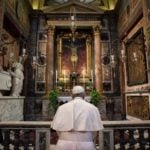About The Church of San Marcello al Corso:
The church of Saint Marcellus was first built in the 4th century, s
The first historical mention of the existence in Rome of a church called “di Marcello” can be found in the letter dated in December 418 AD. It is dedicated to Pope Marcellus I, who was persecuted by the Roman emperor Maxentius and condemned to do the heaviest work in the stables of the catabulum (the central state post office) until he died from exhaustion. You find his tomb here in the church. In 1369 it was entrusted to the Order of the Servants of Mary and is still under their auspices today.
On the night of May 22, 1519 the church was almost completely destroyed by fire; at the stake miraculously a large wooden crucifix was saved, which from that moment became, and still is, the object of great veneration. The rebuilding, which began immediately on a project by Jacopo Sansovino, continued under the direction of various architects, including Giovanni Mangone, Giovanni da Firenze, known as Nanni di Baccio Bigio, and his son Annibale Lippi, to whom the harmonious apse is due.
There are several chapels here in the church, each with impressive works of art. Perhaps the most notable chapel is the Chapel of the Crucifix (fourth chapel on the right as you enter).
The story of the Miraculous Crucifix:
The Crucifix, exhibited in the fourth chapel on the right, has been the object of profound veneration by the faithful of Rome since 1519, when it miraculously remained unharmed in the great fire that destroyed the church.
Three years later, in 1522, a serious plague epidemic spread throughout the city. Then that the Cardinal Titular of S. Marcello, Raimondo Vich, Spanish, to implore divine clemency, promoted in that year a solemn penitential procession in which all categories of people participated: clergy, religious, nobles, knights, men, women, old people and children.
During that procession, which lasted 16 days, the Crucifix was placed on a carrier and processed through all the different districts of Rome, ending up at Saint Peter’s Basilica. Shortly after that, the plague ceased to ravage the city.
Pope St. John Paul II embraced that same crucifix to mark the culmination of the Day of Forgiveness during the Jubilee Year of 2000

On March 15, 2020, Pope Francis visited the Church of Saint Mary Major to pray before the image of Salus Populi Romani (Protectress of the Roman People) and then walked about 1/2 mile to the Church of San Marcello al Corso and prayed before the crucifix asking for relief from the Coronavirus that has quickly become a global pandemic.
According to the church’s rector, Fr. Enrico Casini, Pope Francis also stopped to pray before a statue of St. Joseph. Source: Vatican Media.
As the Corona virus continued to ravage Italy and the world, Pope Francis had the crucifix moved to the steps of Saint Peter’s Basilica, and on March 27, 2020 he prayed for relief from the coronavirus and gave everyone a blessing Urbi et orbi, which had a plenary indulgence attached to it.
Please note: reports that the crucifix “exploded” as a result of being exposed to the rain during this blessing are false…. The Catholic News Agency reports that Fr. Enrico Maria Casini, who is in charge of San Marcello al Corso in Rome, has said the damage to the miraculous crucifix from rain “is not serious,” from what he understands, and it is expected to be returned to the Church of San Marcello al Corso by Easter.
Finding the Church of San Marcello al Corso:
Address: Piazza San Marcello al Corso, 5 – Roma
Tel: +39 06.6793910
Email: sanmarcelloalcorso@gmail.com

